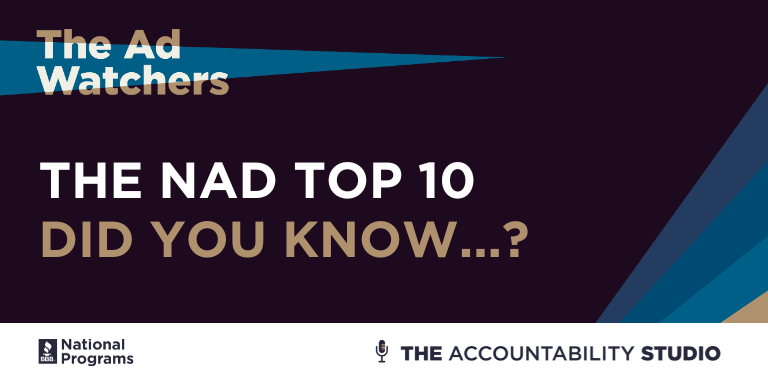
On this episode of the Ad Watchers dynamic duo, Annie Ugurlayan and Dan Range decide to address misperceptions and misconceptions about the National Advertising Division (NAD). As the Assistant Director and an attorney of the program, the two tackle the top 10 of the most common misunderstandings that new and not-so-new participants tend to have about NAD and the challenge process.
Annie admits to listeners that their list may not be as exciting as David Letterman’s top 10 list from Sioux City, Iowa; however, Dan ensures that their top 10 will be on par. Dan kicks us off with the number one source of confusion that participants in NAD proceedings often have. That boils down to understanding the scope of NAD’s review.
2:35- To begin, Dan reminds listeners that NAD looks at truth and accuracy. Since advertising is all about messaging, NAD seeks to understand the intent behind an advertiser’s message to the consumer. What is the advertiser conveying to its audience? Then NAD looks to answer whether the message is true or false. With that being the case, Dan advises challengers to identify the specific messages or claims they are challenging, both express and implied.
Dan provides a bonus tidbit to listeners early in the episode. Another area of confusion deals with the discontinuance of an advertisement versus a discontinuance of a claim. Dan shares that there is a stark difference, and to satisfy an agreement and bring complete resolution to a NAD challenge, a permanent discontinuation of a claim and not just current advertising is necessary. This includes future advertising as well.
5:52- Annie jumps in to clarify another stumbling block regarding what NAD does. This self-regulatory arm of advertising does not create rules and regulations. NAD harmonizes its decision with any relevant regulatory authority. Annie reminds listeners that the Federal Trade Commission (FTC) forms the rules for advertising claims substantiation. NAD and regulatory authorities have different objectives when reviewing ad claims, and each applies different legal standards. If there’s an applicable regulation or agency action that relates directly to a product or a claim, that is what NAD will follow.
There is an exception to this rule as NAD does have jurisdiction over challenges of advertisements that have been subject to review by a federal agency unless those claims are mandated or expressly approved by federal law regulations. Also, there are times when NAD decisions inform regulatory guidance, such as most recently with the endorsements and testimonials guides and the green guides. Annie continues to provide listeners with further examples of how NAD decisions influence the FTC’s and the states’ regulatory efforts.
Dan and Annie continue demystifying NAD, tackling the top 10 NAD myths.
This includes addressing:
- The difference between NAD and the FTC as regulatory entities: NAD is voluntary self-regulation, and the FTC is an enforcement body. Though this is the case, NAD’s and FTC’s shared mission of consumer protection has formed a strong and close relationship between the two.
- Submission of an advertiser’s substantiation in the first instance: Advertisers who submit part of their substantiation in their first response and then part of it in the final response are taking a risk. If a challenger expedites the proceeding, waiving their right to reply, the record is then closed. NAD must now base a decision on whatever was submitted in the advertiser’s initial response.
- Use confidentiality sparingly. Advertisers are well within their right to submit confidential information to NAD with a separate detailed summary of that confidential information. However, remember that it’s important for the challenger to be able to provide a meaningful critique of the evidence supplied. It also helps NAD when writing the decision. The more information provided, “the more informed our decision can be,” Annie advises.
- 17:19- Evidence offered in the form of studies and reports: “The key takeaway for this point is that it’s quality, not quantity,” Dan mentions. An advertiser can provide 10 studies to support their claim, but if each is deficient, they can’t compensate for each other’s deficiencies. NAD is looking for quality studies and quality support.
- Everyone else is doing it: Annie helps listeners recollect their childhood, “That didn’t work in fifth grade, and that’s just really not going to work at NAD.” This defense is often heard in monitoring cases. An important note, NAD has limited resources and is not picking on any company. When advertising is found that NAD thinks needs to be reviewed, “we reach out.”
- When in doubt, play it conservative: Either your claims are supported, or they’re not. If your advertising conveys a message, That you can’t support, you’re subjecting yourselves to a challenge.
- 26:58- Meetings with the NAD are not part of the record: The record is the submission. The meeting is not the time to make new arguments or present new evidence.
- NAD does not pre-approve ads or claims: There’s no ‘supported by NAD’ certification issued to rule out a challenge.
- NAD’s decision is not the end: A compliance review happens next. The challenger looks to see that the advertiser is actually complying with the recommendations. If they find a failure to comply, the challenger provides a letter to the program. NAD proceeds with its own review and request for a compliance plan from the advertiser.
Dan and Annie send listeners off with the hope that this episode clears up some misconceptions and misperceptions of what NAD is and how it works.
Visit to Learn More: NAD FAQs
Contact Information: programs@bbbnp.org
Listen to the full episode here.

